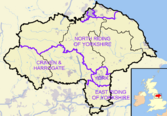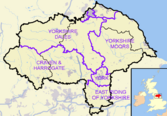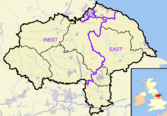History of local government in Yorkshire facts for kids
The history of local government in Yorkshire is quite special and a bit complicated! Yorkshire is the biggest historic county in England. It has a mix of busy cities and quiet countryside, with a past linked to farming, factories, and mining. For a long time, not much changed in how Yorkshire was run. But in more recent times, there have been many big changes to its local government. Some of these changes caused a lot of debate! The most important changes happened with laws like the Local Government Act 1972, the 1990s UK local government reform, and the Localism Act 2011. Today, the historic area of Yorkshire is split into several different counties and districts. Most of it is found within the Yorkshire and the Humber region.
Contents
Ancient Divisions of Yorkshire
Yorkshire started a very long time ago as the Kingdom of Jórvík. This was a Viking kingdom! It was traditionally split into three main parts called West, North, and East ridings.
The word riding comes from an old Norse word, þriðing, which means "third part." This name stuck around because of the Viking settlers who arrived in the area in the 800s.
Each of these ridings was then divided into even smaller areas called wapentakes. These wapentakes were managed by an early form of local meeting called a "Thing". This was a bit like an early democratic meeting where people could discuss local issues. Later, these wapentakes became the basis for how the area was governed.
Around 1823, some of the wapentakes included:
| Riding | Wapentakes (smaller areas) |
|---|---|
| East | Buckrose, Dickering, Harthill, Holderness, Howdenshire, Hullshire, Ouse and Derwent |
| North | Allertonshire, Birdforth, Bulmer, Gilling East and West, Halikeld, Hang East and West, Langbaurgh East and Langbaurgh West, Pickering Lythe, Ryedale, Whitby Strand, City Of York |
| West | Agbrigg and Morley (Agbrigg and Morley divisions), Barkston Ash, Ewcross, Claro Lower and Upper, Morley, Osgoldcross, Skyrack Lower and Upper, Staincliffe East and West, Staincross, Strafforth and Tickhill Lower and Upper |
There was also the Ainsty wapentake, which was just west of the City of York.
Modern Local Government Begins
In 1835, a law called the Municipal Corporations Act 1835 changed how some towns like Beverley, Doncaster, Hull, Leeds, and York were run.
Then, in 1889, a new law called the Local Government Act 1888 made even bigger changes. Yorkshire was split into three "administrative counties." Each of these had its own council to manage local services. These new counties mostly followed the lines of the old ridings. However, large towns like Bradford, Leeds, Sheffield, and York became "county boroughs." This meant they were like their own separate counties, managing their own affairs.
Even with these changes, Yorkshire was still seen as one big county. But it was too large to have just one council for the whole area. In 1894, the rest of the county was divided into smaller urban (town) and rural (countryside) districts.
More county boroughs were created between 1889 and 1974:
| Riding | Main Office | County Boroughs in 1889 | New County Boroughs |
|---|---|---|---|
| East | Beverley | Kingston upon Hull | none |
| North | Northallerton | Middlesbrough (ended 1968) | Teesside (1968) |
| West | Wakefield | Bradford, Halifax, Huddersfield, Leeds, Sheffield, York | Barnsley (1913), Dewsbury (1913), Doncaster (1927), Rotherham (1902), Wakefield (1915) |
Big Changes in 1974
In 1974, the way local government worked in England was completely changed by the Local Government Act 1972. Under this new law, the old ridings and their councils were removed.
The area of Yorkshire was then divided into several new counties. Some were called "metropolitan counties" (for big city areas), and others were "non-metropolitan" or "shire counties" (for more rural areas).
Here's how Yorkshire was divided after 1974:
| New County after 1974 | Area it came from |
|---|---|
| Cleveland (south Tees area) | Parts of the North Riding, including the County Borough of Teesside |
| Cumbria (a small part) | Sedbergh Rural District from the West Riding |
| Durham (a small part) | Startforth Rural District from the North Riding |
| Greater Manchester (a small part) | Saddleworth Urban District from the West Riding |
| Humberside (northern part) | Kingston upon Hull and most of the East Riding, plus Goole from the West Riding |
| Lancashire (a small part) | Bowland Rural District, Barnoldswick, Earby, and part of Skipton Rural District from the West Riding |
| North Yorkshire | York; most of the North Riding; Harrogate, Knaresborough and Selby from the West Riding; and part of the East Riding around Filey |
| South Yorkshire | Barnsley, Doncaster, Sheffield and Rotherham from the West Riding |
| West Yorkshire | Bradford, Dewsbury, Halifax, Huddersfield, Leeds and Wakefield from the West Riding |
This reform aimed to group the busy city areas of the West Riding into the new South and West Yorkshire counties. The other new counties, like North Yorkshire, became mostly rural.
District Name Changes
Some of these changes were not very popular. So, a rule in the 1972 law allowed local district councils to change their names. For example, within the new Humberside county, the Borough of Beverley changed its name to East Yorkshire Borough of Beverley in 1981. This was to show its connection to historic Yorkshire.
County Councils Abolished
In 1986, the main county councils for South Yorkshire and West Yorkshire were removed. Their jobs were then given to the smaller district councils in those areas.
Local Government Changes in the 1990s
Another review of local government happened in the 1990s. This led to more changes to the counties created in 1974.
As part of this review, the counties of Cleveland and Humberside were abolished in 1996. Their districts became "unitary authorities." This means they became single councils that handle all local services, rather than having separate county and district councils.
The East Riding of Yorkshire was also brought back as a county for official purposes, including Hull. North Yorkshire also gained some land for these purposes.
Here are some of the new unitary districts created:
| New Unitary Authority | Old County (1974 to 1996) | Official County (from 1996) |
|---|---|---|
| East Riding of Yorkshire | Humberside: Beverley, Boothferry (part), East Yorkshire, Holderness | East Riding of Yorkshire |
| Hull | Humberside: Hull | East Riding of Yorkshire |
| Middlesbrough | Cleveland: Middlesbrough | North Yorkshire |
| Redcar and Cleveland | Cleveland: Langbaurgh | North Yorkshire |
| Stockton-on-Tees | Cleveland: Stockton-on-Tees | North Yorkshire and County Durham |
| York | North Yorkshire: York and parts of Selby, Harrogate and Ryedale | North Yorkshire |
North Yorkshire Reorganisation in the 2000s
In 2003, the government suggested more changes for local government in North Yorkshire. The idea was to replace the two-tier council system (where there was a county council and district councils) with just one level of "unitary authorities." This would also help areas like Ryedale, which had lost a lot of its population to an expanded York.
Proposed Options
One idea was that Selby council would join with the East Riding of Yorkshire council. The City of York council had already become a bigger unitary council in 1996.
North Yorkshire County Council supported the idea of one big unitary county council. However, most of the smaller district councils wanted things to stay as they were.
In the end, these plans were dropped, partly because people didn't like the idea of new regional assemblies that would come with the changes. The ideas were brought up again in 2007 but were dropped once more.
North Yorkshire Reorganisation in the 2020s
In 2020, the government asked the councils in North Yorkshire to suggest new ways to organise themselves into unitary areas.
Proposed Options
North Yorkshire County Council suggested almost the same idea they had in 2003 and 2007: one big unitary North Yorkshire council, with the City of York staying as it was. The City of York council agreed with this.
However, six of the seven district councils (all except Hambleton) put forward a different idea. They wanted to split the county into an east and west part, and merge York into the eastern council. Discussions on these two options began in March 2021.
Government Decision
On 21 July 2021, the government announced its decision. From April 2023, the non-metropolitan county of North Yorkshire will become one single unitary authority. This means the current county council and the seven district councils will be removed. Their jobs will be taken over by this one new authority. The existing unitary authority for the City of York will not change.
Combined Authorities
Since 2014, "combined authorities" have been created. These are groups of councils that work together on big projects, especially in areas where the metropolitan county councils were removed in 1986.
For example, the combined authority for South Yorkshire was formed in 2014. It was first called the Sheffield City Region Combined Authority, but its name changed to South Yorkshire Mayoral Combined Authority in 2021. The West Yorkshire Combined Authority was also formed in 2014. The Tees Valley Combined Authority was set up in 2016. In 2022, the government suggested creating a combined authority for York and North Yorkshire as well.
Images for kids
See also














